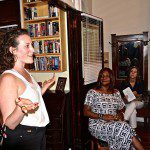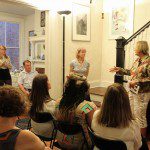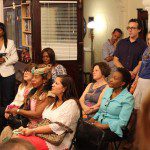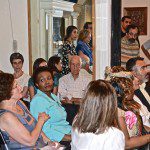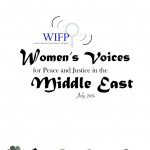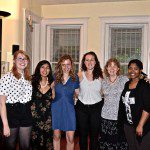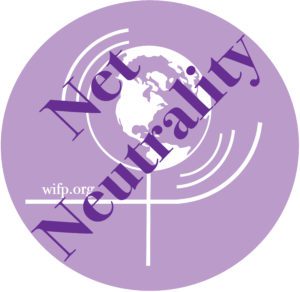Under the Shadow of a Problem: Implications of My Brother’s Keeper for Communities of Color
By Elana Denise Anderson, Ph.D.
One of the most prolific scholars of the 20th century, William Edward Burghardt DuBois, was never directly asked the question, “How does it feel to be a problem?” But he remembers acutely that day in his childhood when he perceived that he was one. Today, men of color are seen not so much as a problem, but as having a problem, a problem that prevents them from succeeding in and on today’s allegedly “post-racial” American societal landscape. On Monday, September 29, 2014, at the Longworth House Office Building, a unique and viable briefing occurred that focused 0n President Barack Obama’s My Brother’s Keeper Initiative, an act that is designed to unequivocally address this issue, and many organizations are jumping on the bandwagon, embracing rhetoric that often hearkens back to the early 20th century, when gender-specific ideologies were a mainstay of the American psyche.
The briefing, titled Gendered Perspectives on Police Brutality and the My Brother’s Keeper Initiative, was paneled by a host of scholars from a variety of social policy organizations, among them the African American Policy Forum (AAPF), the National Organization of Women (NOW) and the Institute for Women’s Policy Research (IWPR). Moderated by Barbara Arwine, the President and Executive Director of the Lawyers Committee for Civil Rights Under Law, an enthusiastic public speaker who motivated the audience with the charisma of a clergyman of color, the discussion was vibrant, informative and wholly engaging. Her opening remarks were centered upon the fact that women and girls, notoriously absent from the narrative of MBK, are hidden in plain sight, and that the question begs to be asked, “what is it about women and girls of color that jeopardizes men and boys so much that they do not deserve to even be included in efforts to address the problems that plague the communities they share?” She correctly asserted that we can not wait to (re)claim the vision of racial justice that fueled the Civil Rights Movements of the mid to late 20th century.
The first to speak was the Co-Founder and Executive Director of the AAPF, Kimberlé Crenshaw, who provided background information. It was Crenshaw who stated that women and girls are beneath the shadow of the problem and that after 20 years of dialogue surrounding the intersections of social phenomena, we as a nation still do not even understand our own policed responses to the economic disparity, violence and silence that characterize the lives of women and girls of color in America and/or around the world. Her assertions about the nature of patriarchy drove home the fact that until there is more reported statistical research (even when research is conducted in communities of color, the data that is collected about women and girls is not a required submission, thereby going under-reported or not reported at all), more briefings such as this and more accuracy and equity in media coverage, the rhetoric will not change.
The only male on the panel, Marlon Peterson, was the first to mention the term hetero-patriarchy as it relates to the issues in communities of color across the nation. In his opinion, MBK misses the mark because it does not address the fact that women and girls are affected in the same ways and just as much as men and boys in their homes and communities, and that addressing the needs of half of the population in these communities will not fix the problem. Peterson was also adamant about the need for community service organizations such as The Fortune Society, of which he is the Director of Community Relations, to address the problems in communities of color more holistically by providing the same level of service for each community member regardless of their circumstances. Too, such organizations can better communicate the realities of their demographic to funders and others who offer support.
Dr. Heidi Hartmann, the President of the Institute for Women’s Policy Research provided statistical evidence that MBK is not making the case for itself through the data it presents. According to Dr. Hartmann, the initiative is based more upon the publicly accepted stereotype that boys and men of color are worse off than girls and women, and not evidence. She said, “Of the 116 statements in the report of MBK’s Task Force, only six stated that boys were worse off than girls, and the 44 indicators to be tracked apply to children indiscriminately, not just boys.” Dr. Hartmann calmly suggested renaming the initiative Our Children’s Keeper and was met with enthusiastic applause.
Lisalyn Jacobs, the Vice President for Government Relations of Legal Momentum, is the single mother of a six-year old son. In her brief statement about the criminalization of the single mother of color she suggested, and rightly so, that the perpetuation or even the advocacy of the idea that men and boys of color are having a unique experience of oppression is just wrong. The President of the United States, raised by a single mother, claimed to be able to relate to the needs of men and boys of color primarily because he grew up without a father in his home. Again, the strange bedfellows of anti-racism and patriarchy raise heads. Single parents of color, be they mothers or fathers do not have some kind of personal failing or shortcoming; they struggle because of economic disparity that is a direct result of racism in the United States. The fact that the majority of men and boys of color may have been raised by a single mother is NOT the reason for their lack of opportunity, education and support, an idea propagated by Daniel Patrick Moynihan in his infamous 1965 report on the Black family. Does MBK continue to blame the victim, namely single mothers of color, for the plight of men and boys of color?
Finally, Terry O’Neill, the President of the National Organization of Women, correlated MBK with the idea that the father-centered family should continue to be a mainstay of American society. “It is a fantasy that”, she said, “like a zombie, will continue to eat people’s brains”. The idea that everything will be fine if we, as Americans, will blindly accept the gender-specific ideas of the past that encourage men and women to behave in certain ways simply because they are men and women is dangerous and offensive. All “isms” – racism and sexism included – must come to an end if we can hope to move forward as a society.
Communities of color suffer from a range of disparities and issues that are often characterized by gender, race and sex, but rarely are economics a part of the conversation. If MBK intends to provide education, employment and mentorship opportunities for half of the populations in these communities, will not America simply be doing what it has always done-attempting to address symptoms without fully addressing the problem? Racism and sexism have long cast a dark shadow over American society. Women and girls, regardless of color, have always been behind, under or trapped within it. Until the voices of women and girls are heard clearly by those who most consistently affect the circumstances of the majority of American lives (still men), they will continue to be considered but an irrelevant whisper, drowned out by the chorus of social construction.
Elana Denise Anderson, Ph.D., is the Associate Director of WIFP.
The “Boy’s Club” of the Gaming World
By Nikki Clemons
The world of gaming has often been classified as a “boy’s club,” with girls and women often absent or underrepresented. The popular view is that games are usually made by men, bought by men, played by men and star men. However, this perception of video games being mostly dominated by the male audience is undermined by studies that show that women make up nearly half of the gaming demographic. According to the Entertainment Software Association’s 2013 “Essential Facts About the Computer and Video Game Industry,” nearly 45% of all players are female. So why is it with this high percentage of women are women themselves so absent or misconstrued in the world of video games?
The most popular place for a female character in the gaming world is as a sexual object. Whether cast as hookers and strippers in gritty gangster games, pedestrians in open world games like Grand Theft Auto, or just skimpily dressed secondary characters, women exist in the virtual world for sex or as embodiments of sex. Even traditionally non-sexual characters, like DC’s Harley Quinn, are redesigned in the gaming world to be sexier and skimpier. Harley’s design went from a one piece jumpsuit in the comics and cartoons to a series of revealing and tight fitting dresses in the Arkham series. Even nameless females suffer the same objectification— the all powerful healing fairies in the famous Legend of Zelda games are garbed in only thin vines and leaves.

The Great Fairy ~ Legend of Zelda: Ocarina of Time
This sexualizing of female characters ties into the lack of diversity and fetishizing of the diversity that is there. In any game with a character creator, the player has the option to design their own character, including hair style, eye colour, clothing options, and body type. In the fighting game Soul Caliber V, the body types for male characters can range from the hilariously muscled to the painfully thinned. The body types for females, however, range from thin to average weights. It is very rare to find a game with a character creator that allows for the creation of a “fat” woman, and games with non-revealing outfits can be equally difficult to find.
In the instances of games without character creators, if the player even has the option to play as a woman, getting the chance to play as a woman of colour is pretty much non-existant. When women of colour are present in games, usually as NPCs (non playable characters), they are stereotyped or fetishized. They are either stereotypes of “sassy” black women, sexual Latinas, or guiding mammy figures. The Gerudo race in the Legend of Zelda: Ocarina of Time, are racist depictions of Middle Eastern-resembling women in croptops. Similarly, any presence of gay or bisexual females leads to fetishizing and sexualizing.
In addition to being sexualized, video game women are also subjected to specific and gendered types of violence. In the 2006 open world game Bully, the male main character can break into several restricted buildings on his campus, one of which is the girl’s dormitory. He can then hide and spy on the female NPCs, and if caught can beat the dorm headmistress with his choice of fists, bricks, baseball bats, or a variety of other weapons. Similarly, in the very popular open world series, Grand Theft Auto, the player can pick up prostitutes, throw money at strippers, and run any female down with their car and beat them to death with their fists. This open promotion of violence against women, sexual harassment, and even undertones of rape, are not just degrading, but also can drive women away from playing games. Playing any game online as a woman, like Call of Duty or Halo, can be uncomfortable since players on the other end of the line tend to threaten rape or sexual degradation, especially upon discovering their opponent player is a woman.
In the few instances where female characters don’t fit any of the above roles, they are often in the role of a dependent. Elizabeth from BioShock Infinite is constantly in modest clothing and is independent and powerful in her own right. However, the player has no chance to actually play as her. Instead they play as Shepard and spend the game toting Elizabeth from place to place and protecting her from attackers. Similarly, Ellie from the apocalyptic The Last of Us requires protection and exists mainly as a secondary character. And of course, there are the typical depictions of women as damsels in distress, often princesses captured by horrible beasts and waiting for rescue from the main male protagonist (see the Super Mario Bros and Legend of Zelda series). In these instances, women are given personalities, powers, and are more independent and less mindless than women in other games. However, they are still submissive and powerless within the confines of the plot, and dependent on the male lead and the presumably male player.

Elizabeth from Bioshock Infinite
And all of this is assuming that women are present in the game at all. During 2014’s E3 conference, an annual conference for the presentation and discussion of video games, James Therein of Ubisoft confirmed there would be no playable female characters in the new Assassin’s Creed games. He explained this absence saying that putting the women in as playable characters would have “doubled the work” to produce the game. This created an outrage and general confusion amongst the fans, as there were previous games where the player could be female assassins.
Women are so often denied roles even in industries where they nearly dominate sales and play time. The few times they are granted roles, they’re empty background characters in skimpy clothing, there for the male player to protect, objectify, or destroy. Women have no agency in the very open world games that are supposed to give them just that. Video games are still a “boy’s club,” ultimately, even though half of those boys are girls.
Nikki Clemons is a WIFP staff writer.
Event: Women’s Voices for Peace & Justice in the Middle East
Exploring women’s narratives in the Middle East focusing on the Israeli-Palestinian conflict. Speaker: Ann Wright – July 20, 2014. Launch of booklet “Women’s Voices for Peace and Justice in the Middle East.”
- Booklet
- Some of WIFP staff at event
- Photographers Alethea & Delma
Karma Abuayyash: Gender Gap in Palestinian Society
I am Power Hungry Woman: The Gender Gap in Palestinian Society
By: Karma Abuayyash, WIFP staff
All across the world, women have long fought for equality, recognition, and a presence in the political arena. In times of war and conflict these struggles became even more prominent, a situation very recognizable by the Palestinian women. Both the patriarchal nature of Arab society and the restrictions enforced by the Israeli occupation shackle Palestinian women in their fight for societal and political freedom. However, since the beginning of the twenty-first century, Palestinian women have been working to make their collective voice heard and reduce the gender gap within their society. Looking back at the first Civil Uprising in 1987, the seed of a feminist movement had begun to develop, which enforced social change. As women became more active and politicized, the feminist movement gained momentum; the fight was not only against the occupation, but also against the restrictive norms of society. Women undertook prominent roles in the first civil uprising, standing shoulder to shoulder with their male counterparts, which thrust the subjects of gender equality and women’s rights into the spotlight.
Nowadays, the percentage of women participants in the political arena is diminishing. Although this might appear to be a negative phenomenon, as Palestinian women are currently less active in the actual fight against the occupation – in comparison to the first civil uprising -they have been taking more significant roles in other mediums such as journalism and media. During the last couple of years, the number of women majoring in journalism and media in the Palestinian universities has been increasing. For example, in Birzeit University – one of the leading universities in Palestine- the ratio of female students to male students is 4:1. One of the main reasons might be the low wage a media graduate gets when hired.
However, due to the patriarchal nature of Palestinian and wider Arab culture, which views women as less capable of both journalism and politics, women tend to wait in line for years to get a job as a journalist. Although there have been many leaps forward, the disparity between the sexes is still clear. While tradition may be good for social cohesion, it can have a limiting effect on progress and prosperity in Palestinian society. One example of such gender discrimination by the Palestinian media channels is their tendency to discriminate between the two sexes when vacancies open, the majority of the media channels and outlets in Palestine hire male applicants instead of female applicants regardless of the females’ superior skill sets, knowledge or experience.
In conclusion, Palestinian women have to break free from their internalized misogyny established by patriarchal social constructs and realize their inner power. These women are just as equal and qualified as any successful male activist or journalist. Madhulika Sikka – the Executive Editor for NPR News- emphasized the actions Arab women should take in their own societies when she was asked to voice her opinions on this matter on the panel of “Closing Journalism’s Gender Gap: A Forum on Women and Leadership” that was hosted by Poynter and the National Press Club Journalism Institute. The idea that women are inferior to men in patriarchal societies has to change, and this change will only come from within.
 The Women’s Institute for Freedom of the Press
The Women’s Institute for Freedom of the Press
